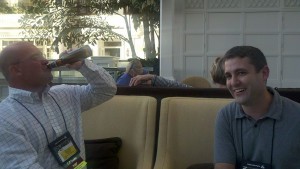 I was asked the other day if it was worth being a member of PMI. I wasn't completely sure. See, you can be a PMP in good standing but not have to be a member of PMI. It's strange to me but true. Granted, as a member, you get discounts to attend events and go to networking events (if you're into that). But, was there real value to me?
Last night I had the pleasure of hanging out with Mike Cottmeyer, Jesse Fewell, Brian Bozzuto, and Dennis Stevens. They were all in Washington DC, attending the PMI Leadership Institute Meeting (LIM) and representing the PMI Agile Community of Practice (CoP). Now, I will be at the PMI Global Congress Sunday through Tuesday but these guys are in town this week.
I was asked the other day if it was worth being a member of PMI. I wasn't completely sure. See, you can be a PMP in good standing but not have to be a member of PMI. It's strange to me but true. Granted, as a member, you get discounts to attend events and go to networking events (if you're into that). But, was there real value to me?
Last night I had the pleasure of hanging out with Mike Cottmeyer, Jesse Fewell, Brian Bozzuto, and Dennis Stevens. They were all in Washington DC, attending the PMI Leadership Institute Meeting (LIM) and representing the PMI Agile Community of Practice (CoP). Now, I will be at the PMI Global Congress Sunday through Tuesday but these guys are in town this week.
Well, last night I spent 6 hours with them. So, ask me again if it's worth being a member of PMI. My answer is now a confident yes. I say yes, not so much for being a member of PMI but rather being a member of the Agile CoP. These four fellows are the kind of Agile thought leaders you want to talk to, if you ever need some inspiration. If these four are what you get when you team PMI and an Agile CoP, I see a great future.
I was going to go into some details of our conversations, but it would probably be 5-pages of me ranting about stuff with stopping points when one of the guys hands me another beer.
I genuinely had an awesome time and am inspired by each of them.
If you are a PMP and are passionate about Agile, I would strongly recommend you get involved with the PMI Agile Community of Practice. Not sure quite yet? Then at least do yourself the favor of looking these guys up, read what they have written, go listen to them speak, or get some training from them.
If you're reading my blog and you're in need of some Agile Training, Agile Coaching, or Agile Transformation, send me an email and I will reach out to my ever-growing Agile circle of friends.



 , we're going to write a little self-contained story on an index card, post-it note, or something similar. When we're done, we're going to add the story card to our kanban board. Our user stories are written from the perspective of the user. In the case of the
, we're going to write a little self-contained story on an index card, post-it note, or something similar. When we're done, we're going to add the story card to our kanban board. Our user stories are written from the perspective of the user. In the case of the 



